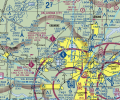Harry Mudd
Filing Flight Plan
- Joined
- Sep 17, 2020
- Messages
- 4
- Display Name
Display name:
Harcourt
The Obsitcal Departure Procedure for KAUN crosses over Beal Air Force Base. Typically, there is a TFR over Beal and the ODP goes right though it. The TFR requires pilots to squawk a code and be in contact with ATC. So an IFR flight should be ok as long as you contact ATC before reaching the TFR. KAUN is untowered, so we may need to contact ATC in the air. What if, for some reason, we can not contact ATC before reaching the TFR? I think I would just continue to fly the DP. Is there a better way?
Also, normally you do not need permission to fly an ODP. Does that change if the ODP crosses some special airspace (TFR, MOA, class C/B). Of course it's always best to tell ATC your flying the ODP. But I'm wondering if it is actually required in some situations.
Also, normally you do not need permission to fly an ODP. Does that change if the ODP crosses some special airspace (TFR, MOA, class C/B). Of course it's always best to tell ATC your flying the ODP. But I'm wondering if it is actually required in some situations.

